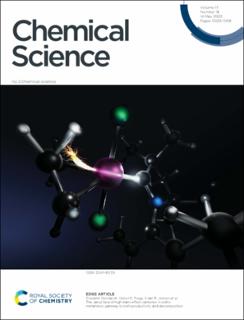| dc.contributor.author | Occhipinti, Giovanni | |
| dc.contributor.author | Nascimento, Daniel L. | |
| dc.contributor.author | Foscato, Marco | |
| dc.contributor.author | Fogg, Deryn Elizabeth | |
| dc.contributor.author | Jensen, Vidar Remi | |
| dc.date.accessioned | 2022-12-12T12:40:09Z | |
| dc.date.available | 2022-12-12T12:40:09Z | |
| dc.date.created | 2022-10-19T11:03:01Z | |
| dc.date.issued | 2022 | |
| dc.identifier.issn | 2041-6520 | |
| dc.identifier.uri | https://hdl.handle.net/11250/3037274 | |
| dc.description.abstract | Ruthenium–cyclic(alkyl)(amino)carbene (CAAC) catalysts, used at ppm levels, can enable dramatically higher productivities in olefin metathesis than their N-heterocyclic carbene (NHC) predecessors. A key reason is the reduced susceptibility of the metallacyclobutane (MCB) intermediate to decomposition via β-H elimination. The factors responsible for promoting or inhibiting β-H elimination are explored via density functional theory (DFT) calculations, in metathesis of ethylene or styrene (a representative 1-olefin) by Ru–CAAC and Ru–NHC catalysts. Natural bond orbital analysis of the frontier orbitals confirms the greater strength of the orbital interactions for the CAAC species, and the consequent increase in the carbene trans influence and trans effect. The higher trans effect of the CAAC ligands inhibits β-H elimination by destabilizing the transition state (TS) for decomposition, in which an agostic MCB Cβ–H bond is positioned trans to the carbene. Unproductive cycling with ethylene is also curbed, because ethylene is trans to the carbene ligand in the square pyramidal TS for ethylene metathesis. In contrast, metathesis of styrene proceeds via a ‘late’ TS with approximately trigonal bipyramidal geometry, in which carbene trans effects are reduced. Importantly, however, the positive impact of a strong trans-effect ligand in limiting β-H elimination is offset by its potent accelerating effect on bimolecular coupling, a major competing means of catalyst decomposition. These two decomposition pathways, known for decades to limit productivity in olefin metathesis, are revealed as distinct, antinomic, responses to a single underlying phenomenon. Reconciling these opposing effects emerges as a clear priority for design of robust, high-performing catalysts. | en_US |
| dc.language.iso | eng | en_US |
| dc.publisher | Royal Society of Chemistry | en_US |
| dc.rights | Navngivelse 4.0 Internasjonal | * |
| dc.rights.uri | http://creativecommons.org/licenses/by/4.0/deed.no | * |
| dc.title | The Janus face of high trans-effect carbenes in olefin metathesis: gateway to both productivity and decomposition | en_US |
| dc.type | Journal article | en_US |
| dc.type | Peer reviewed | en_US |
| dc.description.version | publishedVersion | en_US |
| dc.rights.holder | Copyright 2022 The Author(s) | en_US |
| cristin.ispublished | true | |
| cristin.fulltext | original | |
| cristin.qualitycode | 2 | |
| dc.identifier.doi | 10.1039/d2sc00855f | |
| dc.identifier.cristin | 2062685 | |
| dc.source.journal | Chemical Science | en_US |
| dc.source.pagenumber | 5107-5117 | en_US |
| dc.relation.project | Norges forskningsråd: 262370 | en_US |
| dc.relation.project | Norges forskningsråd: 288135 | en_US |
| dc.relation.project | Norges forskningsråd: 226244 | en_US |
| dc.relation.project | Sigma2: NN2506K | en_US |
| dc.relation.project | Sigma2: NS2506K | en_US |
| dc.identifier.citation | Chemical Science. 2022, 13 (18), 5107-5117. | en_US |
| dc.source.volume | 13 | en_US |
| dc.source.issue | 18 | en_US |

